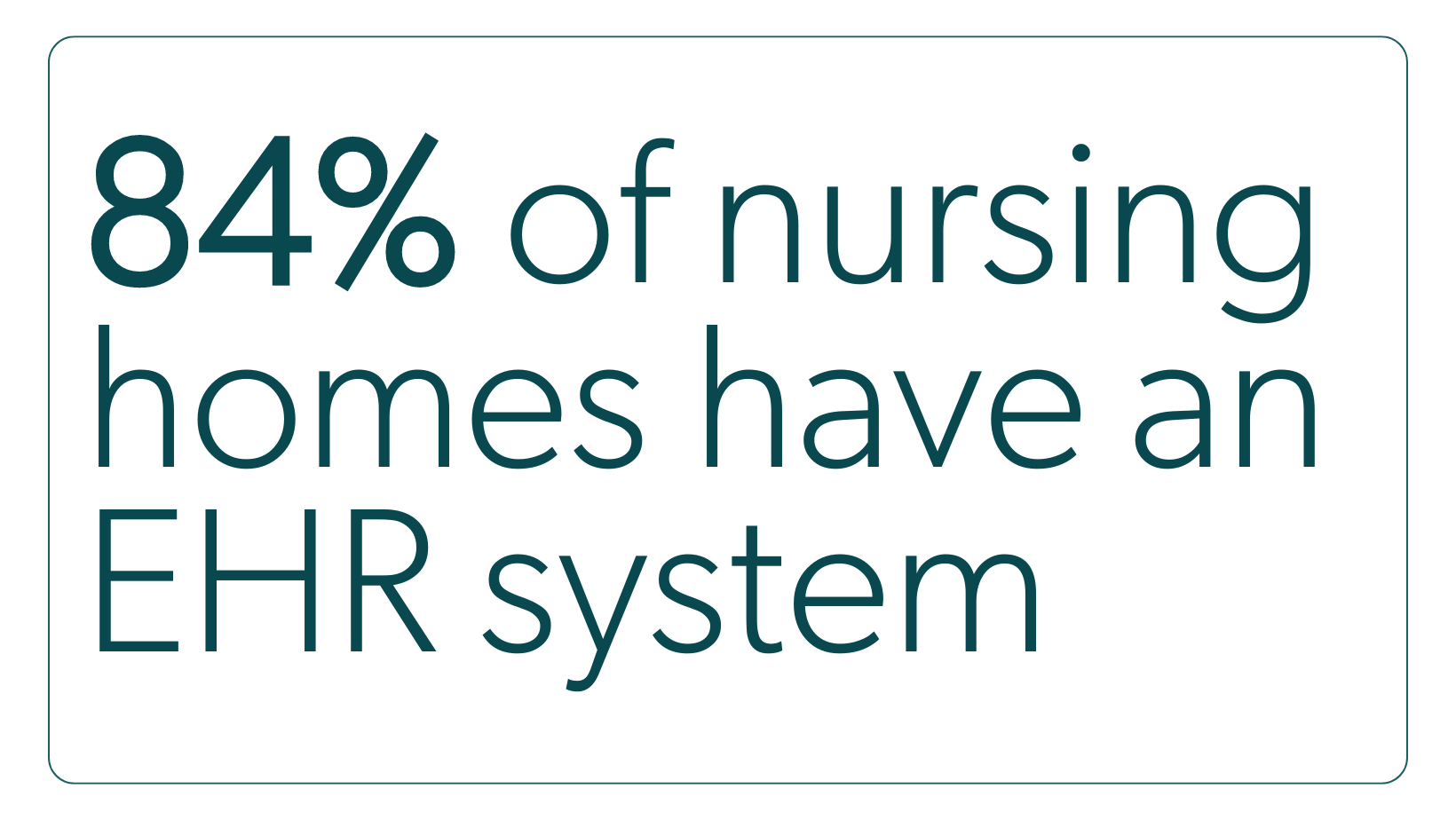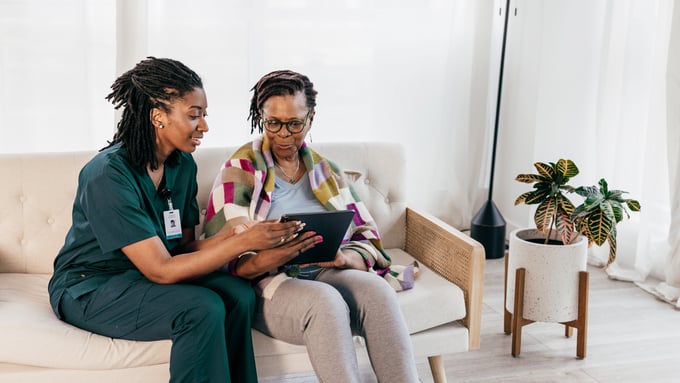Senior Care Technology Trends: What to Look Out For
Explore the latest senior living technology trends and innovation, from artificial intelligence to cloud computing technologies, and more.
Learn how to leverage vital sign technology to transform your senior care facility. We’ll cover healthcare technology options and outline their transformative power.
Countless nursing homes have adopted basic healthcare technologies to boost care quality and stretch their resources. One of the most common tech types is the electronic health records (EHR) system. In 2019, 84% of American nursing homes had such a system. And as time has progressed, opportunities for technological investments have expanded.
Leaders of nursing facilities are looking for technological advances to replace outdated practices like manual data entry and handwritten vitals documentation. Solutions for these can pay dividends in improving care quality, staff time savings, streamlined workflows, and much more.

Regardless of the current state of your skilled nursing facility, there’s always room for improvement, especially when you consider technology’s widespread capabilities.
In this guide, we’ll share how vital sign monitoring technology can transform your skilled nursing facility (SNF) for the better. We’ll cover everything from the benefits of healthcare technology to the top vital sign technology solutions for nursing facilities. Let’s get right into it!
It’s impossible to overestimate the impact of technology on the healthcare space. Per the Agency for Healthcare Research and Quality, technology has transformed various areas of the healthcare landscape, enhancing patient safety through:
During the COVID era, there was a widespread adoption of technology, with Zoom calls and telehealth visits becoming very common in doctors’ offices, nursing homes, and elsewhere. These technologies bridged the gap between patients, healthcare professionals, and families at an unprecedented time.
But that’s not the extent of healthcare technology advancement. Here’s a quick rundown of some of the most important technological innovations:
The above doesn’t even scratch the surface of technology in healthcare.
Advanced technology lends such an advantage to tech-savvy facilities that those that fail to adapt risk fading into the background.
 Healthcare technology for nursing facilities
Healthcare technology for nursing facilitiesNursing facilities demand specific technology to promote positive health outcomes for residents. For this reason, blindly following general healthcare technology trends for your facility is inappropriate. You need technology designed for nursing facilities.
Electronic health record (EHR) systems are widely used in skilled nursing facilities. Often, residents come into the facility with a significant medical history spanning multiple providers. These nuances can be difficult to track without a centralized system to house them all. The EHR is a centralized system.
In addition, EHR systems come in different configurations and feature unique functionalities suited to long-term care facilities. These systems are regularly associated with benefits like enhanced compliance, streamlined documentation, and simplified medication management. And the benefits don’t end there.
Here are some other technological advances that lend themselves well to the LTC setting:
There are countless technological advances available to nursing facilities. There isn’t nearly enough room to cover them all here. If you want to learn more about SNF technology, be sure to read blogs and news on the topic. You can also window shop online to get a better idea of your options.
An increasing number of SNFs are jumping on the technology bandwagon to alleviate ongoing staffing issues and promote financial stability, among other things. You’ll want to be in that number to remain competitive. The time to invest in technology for SNFs is now.
Now that you have a solid understanding of technology in healthcare and the senior care space, it’s time to turn our focus to vital sign monitoring technology, which is on the cutting edge of advances today. Before we dive into the vitals management benefits, we’ll give you a quick primer on what it is and what it entails in the LTC setting.
Senior care administrators are sure to know the basics of vital sign monitoring. It involves taking and tracking residents’ vital signs to gauge their health status. But there’s much more to it than that. Here are a few aspects of vital sign monitoring that are pertinent to running a skilled nursing facility:
Note: This is not an exhaustive list of functions related to vital sign monitoring in skilled nursing facilities.

The term “involved” doesn’t begin to explain what vital sign monitoring is. But that’s no reason to neglect it. Vital sign monitoring is key to the success of any skilled nursing facility, as it offers several important benefits for all involved, from residents and their families to staff members to administrators themselves. Let's take a look at some of the benefits.
The primary function of vital sign monitoring is to keep tabs on each resident’s health status. Is their condition static, improving, or deteriorating? Clinical professionals can use vital sign measurements to figure this out. With regular vital sign measurements, nurses and doctors can pinpoint health issues and intervene immediately to combat them. The more often vitals are checked, the quicker staff can sense health deterioration.
Vital sign data applies to a wide variety of medical scenarios. Healthcare professionals can use it to craft resident care plans, inform diagnostic testing, and gauge treatment effectiveness.
Facility administrators, data analysts, and other professionals can review vital sign data over time from a more data-centric standpoint. The data may reveal that a staffing change is needed or that some health interventions are more effective than others. Then, you get the opportunity to pivot in a meaningful way. Vital sign monitoring provides the data and insights you need to make informed decisions poised to improve your facility.
Data security is at the core of vital sign monitoring. Those who invest time and resources into this function typically manage vital signs using encrypted, secure data programs and applications.
HIPAA, PIPA, and PIPEDA regulations are applicable to nursing facilities in North America. Advanced vital sign technology and tools ensure that your residents’ medical, personal, and financial records remain protected from unauthorized access, disclosure, or alteration.
This calibre of security is simply impossible without vital sign monitoring technology.
If you recall, vital sign monitoring requires in-depth and ongoing training for nursing staff, medical assistants, and other clinical and administrative staff. When your facility staff is adequately trained on the functions that keep the facility operating at peak capacity, they become even more skilled. The more capable your staff are, the better care your facility can provide.
Turnover is a huge expense, given that management must allocate funds to prospecting, interviewing, and training new talent to replace past employees. On top of that, federal regulations and local laws purposely limit nurse turnover. Excessive turnover could deem your facility non-compliant. CMS also considers turnover when calculating your facility’s Nursing Home Care Compare Five-Star Rating.
Piggybacking on the previous benefit — more capable staff — well-trained staff are less likely to leave the facility for another job. They feel confident in their work function and can rely on their team members to handle theirs.
So, every senior care facility should actively strive to reduce staff turnover, and vital sign monitoring could help tremendously.
Though some may shy away from vital sign monitoring technology due to its upfront costs, the cost savings associated with it can be significant. Here are a few ways nursing homes can save money through effective vital sign monitoring:
Considering the above benefits, vital sign monitoring in the LTC setting enables your facility to provide better care, improving your residents’ health outcomes.
 How to take full advantage of vital sign healthcare technologies for SNFs
How to take full advantage of vital sign healthcare technologies for SNFsIt’s not enough to learn about your technology options and their benefits. According to a study published in the Journal of the American Medical Directors Association, 1 in 3 long-term care facilities abandon new technology within two years of adopting it. This stat highlights the importance of preparation when considering new technologies. This section will be extremely helpful if you want to take full advantage of vital sign healthcare technology for your facility.
Many nursing homes don’t have the manpower or capacity to take on new technologies, frameworks, and workflows. However, if you can secure software designed to take the guesswork out of vital sign monitoring, you can ease the transition, transforming your facility without as many growing pains.
What is VitalLink? It’s a senior care software solution created to enhance your facility’s capabilities and enrich your resident’s lives. The all-in-one application instantly transfers vital sign data from Bluetooth-enabled vitals devices to your EHR system. Once transferred, authorized staff can adjust the vitals data per your typical workflow. Some of the most helpful features and benefits the software boasts include:
Any senior care administrator who wants to transform their facility should consider VitalLink.
We can’t stress enough the importance of pilot programs when trying out new vital sign tech. It’s always a good idea to test-drive new innovations on a small scale before fully rolling them out. Doing so allows you to determine with certainty whether a solution is going to be a benefit to your facility. And if it isn’t the best fit, you won’t have made an astronomical investment in the product for nothing.
Anyone dealing with vital sign data in any capacity should receive training to leverage it properly. Nursing home care is getting more technical by the year, so keeping staff updated is crucial. Failing to do so can put a damper on the benefits you stand to gain from vital sign monitoring.

As technology evolves and your facility’s needs change, you may find that your vital sign monitoring system or processes need an update. Doing periodic resident and staff feedback surveys, tracking clinical outcomes, and reviewing your financials can all yield insight into your vital sign tech’s effectiveness.
Because of the neglected and sometimes deplorable conditions, some residents have found themselves in over the years, the nursing home industry has become very highly regulated. The U.S. government is cracking down on skilled nursing facilities with widespread reforms to ensure residents’ safety. And the same is happening in Canada with the Safe Long-Term Care Act and the Fixing Long-Term Care Act.
Here are a few ways to ensure vital sign monitoring is conducted in a compliant manner:
Read this article to learn more about maintaining compliance in your nursing facility. You’ll find actionable insights to keep your facility on the straight and narrow.
So, there you have it — how vital sign monitoring can help you turn your facility around. Just remember that making lasting and far-reaching improvements will take a sustained effort over time. There are no overnight results, even with technological assistance. So, take things one step at a time and utilize the tips in this article for guidance. We wish you the best as you guide your facility to the next level.
Explore the latest senior living technology trends and innovation, from artificial intelligence to cloud computing technologies, and more.
Are you a senior care administrator grappling with compliance for your facility? Learn about automated vital sign monitoring tech solutions that can...
Senior care facilities often struggle to provide high-quality care to their residents. Find out how vital sign monitoring could enhance your senior...